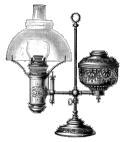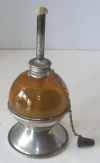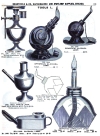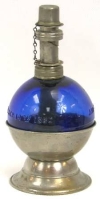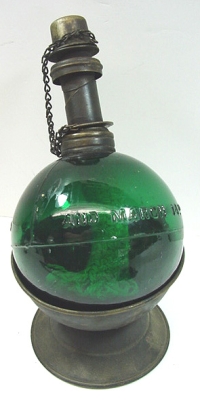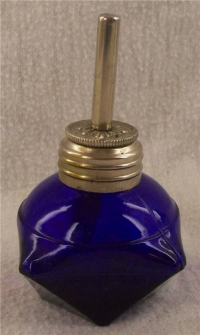a few words about...
I occasionally receive e-mails asking for help identifying round colored glass lamps. Most often these turn out to be jeweler's lamps. As the name suggests, these small lamps were used by jewelers and watchmakers for various tasks including melting wax and soldering. They were made in both clear glass and a variety of colors: ambers, greens and blues. The spherical lamps were sold with a base similar in shape to an egg-cup as seen in the accompanying images. The round fount fit loosely in the holder. This would allow the user to position the flame in any position beneficial to the task at hand, either vertically, or at some other angle by rotating the fount within the semi-circular holder. Indeed, many of these spherical lamps are found without their bases, which often confuses the owner even more about its intended use.
Throughout history, there has been no shortage of catastrophes attributed to open flame lamps and jeweler's lamps were apparently no exception. The following excerpt is from The Jeweler's Circular And Horological Review dated September 30, 1891: "A fire occurred Tuesday afternoon in the window of H. M. Mather's jewelry store, Meriden. A curtain of flimsy netting, which had been hung across the window, blew into the flame of the jeweler's lamp and ignited. The blaze was a brisk one for a few minutes, but was soon extinguished without further damage." Another incident was reported in the August 13, 1902 edition: "Jay W. Nickels, a jeweler, of 441 State St., is suffering from serious injuries to his face and eye, the result of an explosion of an alcohol lamp in his store. Mr. Nickels was alone at the time and had just lighted the lamp to do some work. The flaming alcohol was driven over his face and he was almost knocked down by the concussion. He extinguished the flames with a coat, but not before he was badly burned. The jeweler went to Dr. Plumb Brown, who dressed his wound and discovered that his left eye was badly affected." On June 26, 1883 Norman Clark of Sterling, Illinois invented (U.S. patent 279,915) an alcohol lamp which had a multi-faceted base. These were made of glass with facets of varying angles around the base which allowed the lamp to sit upright, or at an angle corresponding to whatever angles were molded into the glass. Typically, this allowed for three positions without the need for a separate base. The patent date is often molded into the center of the base. Lamps conforming to Clark's patent were advertised in the Swartchild & Co. Illustrated Trade Catalogue and Price List in 1897. They were listed as the "Improved Simplicity Lamp" and were sold in three sizes: small, medium and large and ranged in price from $.50 to $.70. Interestingly, jeweler's lamps of the same design as the Clark lamp are still being manufactured and sold today, albeit in a rather bland colorless glass. So after more than 120 years, the design and function remains the same.  Patent Search Interface Patent Search InterfaceTo view any of the patents referenced in this article, enter the patent number in the field below and click Query USPTO Database. This will open in a new window and take you to the U.S. Patent & Trademark Office Database - directly to the patent in question. Learn more about the USPTO here.
|
